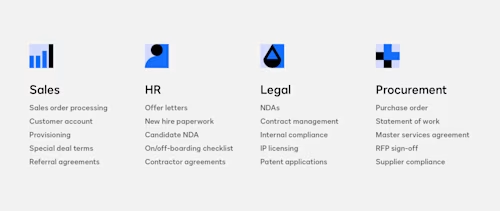Docusign Customer Awards 2025: Celebrating Innovation and Outstanding Achievements

Learn how your organization can save time and money by automating, digitizing and integrating your agreements.

Every organization has a system of agreement for preparing, signing, acting on and managing agreements. In most cases, it involves a series of manual processes and office technologies such as printing, scanning, emailing and faxing—and it’s not consistent from department to department.
Companies that use legacy systems of agreement:
Waste time, taking days or weeks to do what they could do in minutes or hours
Waste money, spending five to 10 times as much as they would if they automated agreements
Lose revenue to faster, more efficient competitors
Create poor experiences for customers and employees by putting them through outdated processes
Increase risk and compliance exposure due to a lack of standardization and security
For companies that want to overcome the inefficiencies in their agreement processes, it’s essential to digitize paperwork and automate tasks. It’s also important to integrate all the systems that are part of the process. For example, a sales team that works in Salesforce shouldn’t have to switch to a different system every time they want to send a sales contract.

Until recently, there has been little focus on automating agreement processes, even though agreements are everywhere throughout the organization. Your organization can save time and money by automating, digitizing and integrating your agreements in the same way you’ve done for your other processes. Here’s how.
The typical agreement process has four stages. For example, to complete a sales contract:
The sales rep must prepare the contract based on an approved quote
The contract has to be signed by the customer
Your company must act on the obligations in the contract, including provisioning a new customer and setting up billing for that customer
Your legal team needs to manage the completed contract and keep track of any milestones that may trigger pricing changes or additional obligations
By adopting a modern system of agreement, you can dramatically increase efficiency and reduce costs at each stage.
Most enterprises still manually collaborate on agreements as they get them ready for signing. The most common tool for contract generation is still Microsoft Word. Companies’ reluctance to move away from Word has resulted in lengthy contract generation periods. As teams email versions back and forth to various stakeholders for review, there are delays that drag down productivity. This process can also introduce risk; 32 percent of organizations have shared a contract with the wrong party.
With a modern system of agreement, you can:
Generate a contract that is accessible to all stakeholders and updated with real-time revisions in a single location
Pull data from systems of record to automatically populate parts of an agreement
Deploy a wizard-like experience to prompt signers to provide the correct information
Allow multiple parties to review, redline and collaborate—without endless email chains
Is your organization still using wet signatures? It used to be standard practice that any important agreement had to end with parties meeting face-to-face to sign papers. Now that companies are readily adopting e-signature technology, they’re accelerating turnaround times for contracts, reducing costs, eliminating errors—and moving one step closer to an end-to-end digital agreement cycle.
Modern systems of agreement eliminate manual steps and automate signature workflows, enabling you to:
Route any agreement to multiple parties with different roles, in order or in parallel
Identify each signer with a method appropriate to the agreement type and regional laws
Monitor participant status to expose bottlenecks
Certify the signing process and the completed agreement
Some of your agreements may require payments. Others trigger new processes once they are complete. Either way, if your team manually extracts information from the contract and enters it into other systems, delays and errors are inevitable.
Automating these processes enables you to:
Transfer payment amounts automatically to a billing system—or collect it at signing
Transfer new or updated information automatically from the signer back to relevant systems of record
Trigger other processes based on any agreement’s completion
How are you storing your completed agreements? Most companies have digitized document storage—but that doesn’t mean they can easily find agreements when they need them. Organizations often stash agreements in random folders on the network or individual hard drives. At best, they’ve established a central repository but load agreements into it manually. In any case, stakeholders tend to forget about these documents once they’ve stored them.
Your company can do better. Using a modern system of agreement, you can:
Store agreements centrally, or at least maintain centralized access to contracts stored in multiple locations
Search agreements based on a variety of criteria
Report on agreement completion, turnaround time and various other trends
Analyze agreement clauses for risks and opportunities
A modern system of agreement can help your organization save time, reduce costs, mitigate risk and deliver a better customer and employee experience. Here’s how that success looks in numbers:
Of all successful Docusign eSignature transactions, 80 percent are completed in less than 24 hours and 44 percent within 15 minutes.
With Docusign CLM, organizations reduce their average contract turnaround time from 24 to four working hours, or 83 percent.
In addition, organizations that have transitioned to digital agreement processes experience faster deal cycles, fewer silos and easier information transfer.
To modernize and unify their systems of agreement, many organizations are adopting the Docusign Agreement Cloud. Most start with Docusign eSignature, then connect and automate other parts of the agreement process. At each step, they gain the ability to do business in a way that’s faster, simpler, more cost-efficient and easier on the environment, while delivering a better experience for customers, partners and employees.
The agreement process doesn’t have to be an obstacle to your efficiency or a drag on your bottom line. Modern systems of agreement streamline the prepare, sign, act and manage phases to help you save time, reduce costs, mitigate risk and deliver a better customer and employee experience. To learn more, explore Docusign Agreement Cloud.
Related posts
